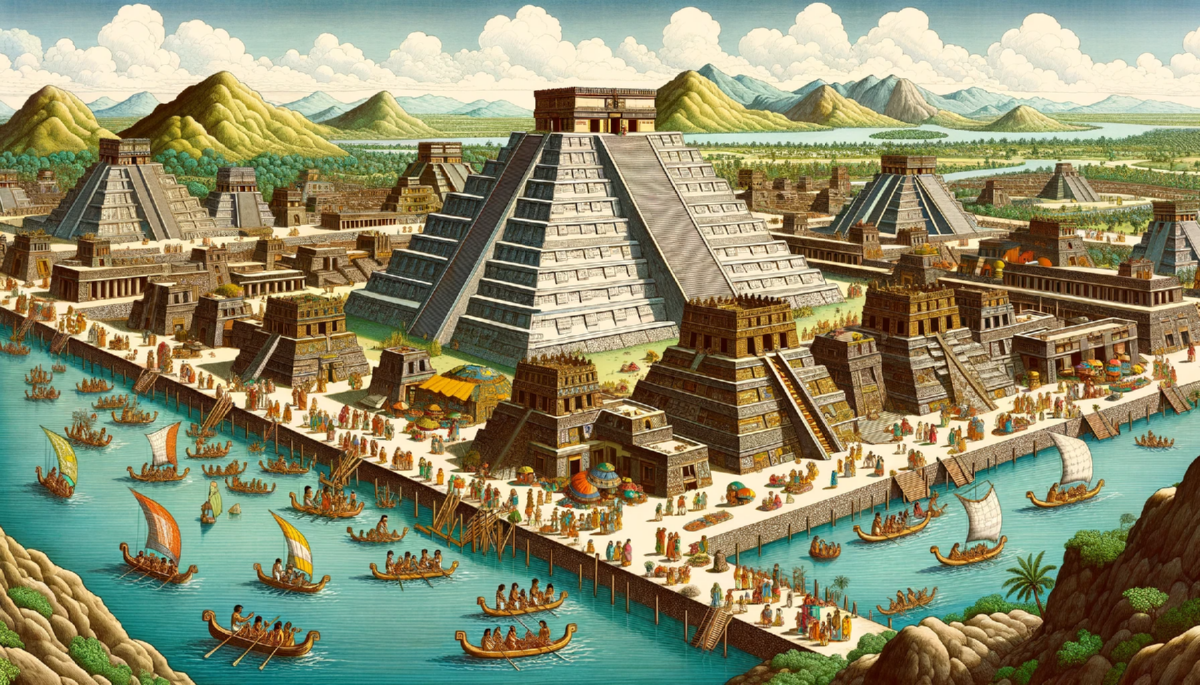
In the annals of history, few cities capture the imagination quite like Tenochtitlán, the ancient capital of the Aztec Empire. Founded in 1325, this majestic city was not just the political center of a powerful empire, but also a marvel of engineering, religion, and culture. Standing on an island in Lake Texcoco, in the heart of present-day Mexico City, Tenochtitlán offers a fascinating glimpse into a complex society that thrived centuries ago.
The Foundation of Tenochtitlán
According to legend, the Mexica people, who later became the Aztecs, were guided to this location by their god, Huitzilopochtli. The sign to settle, as per their mythology, was an eagle perched on a cactus, devouring a snake. This powerful symbol is enshrined in Mexico’s national flag today. The choice of location, on an island in a lake, offered natural defense and a rich aquatic ecosystem that could sustain a growing population.
Urban Design and Architecture
Tenochtitlán was a marvel of urban planning and architecture. The city was divided into four zones, each with its own subdivisions, governed by local lords. At its center stood the Templo Mayor, a massive pyramid dedicated to the gods Tlaloc and Huitzilopochtli. Around this sacred precinct were other important structures, including the ball court, the palace of Moctezuma II, and various temples and markets.
One of the most remarkable aspects of Tenochtitlán was its system of canals and causeways that linked the island to the mainland and other parts of the lake. These waterways were the city's lifelines, facilitating the movement of people, goods, and even armies. The city also boasted a complex system of aqueducts and reservoirs for fresh water, an essential feature for its survival.
Cultural and Religious Life
Religion permeated every aspect of Aztec life, and Tenochtitlán was its epicenter. The Templo Mayor, where the most important religious ceremonies were held, was a site of human sacrifices, believed to appease the gods and ensure the continuity of the world. The city was also a center of learning, with a rich tradition of art, poetry, and music.
The Spanish Conquest
The arrival of Spanish conquistadors led by Hernán Cortés in 1519 marked the beginning of the end for Tenochtitlán. After a siege that lasted several months, the city fell in 1521. The Spaniards, astonished by its beauty and scale, nevertheless destroyed it systematically to build what is now Mexico City. The remains of the Templo Mayor and other structures were only rediscovered centuries later, offering invaluable insights into Aztec civilization.
Legacy and Modern Significance
Today, the ruins of Tenochtitlán are a poignant reminder of a lost world. Archaeological excavations continue to reveal its secrets, providing a deeper understanding of Aztec society. The influence of Tenochtitlán lives on in Mexican culture, art, and national identity, a testament to the enduring legacy of this once-great city.
In conclusion, Tenochtitlán was not just the heart of an empire; it was a testament to human ingenuity and resilience. Its story, from its legendary founding to its tragic fall, continues to fascinate and inspire. As modern Mexico City thrives above its ruins, Tenochtitlán remains a symbol of the rich and complex history of the Americas.
The Foundation of Tenochtitlán
According to legend, the Mexica people, who later became the Aztecs, were guided to this location by their god, Huitzilopochtli. The sign to settle, as per their mythology, was an eagle perched on a cactus, devouring a snake. This powerful symbol is enshrined in Mexico’s national flag today. The choice of location, on an island in a lake, offered natural defense and a rich aquatic ecosystem that could sustain a growing population.
Urban Design and Architecture
Tenochtitlán was a marvel of urban planning and architecture. The city was divided into four zones, each with its own subdivisions, governed by local lords. At its center stood the Templo Mayor, a massive pyramid dedicated to the gods Tlaloc and Huitzilopochtli. Around this sacred precinct were other important structures, including the ball court, the palace of Moctezuma II, and various temples and markets.
One of the most remarkable aspects of Tenochtitlán was its system of canals and causeways that linked the island to the mainland and other parts of the lake. These waterways were the city's lifelines, facilitating the movement of people, goods, and even armies. The city also boasted a complex system of aqueducts and reservoirs for fresh water, an essential feature for its survival.
Cultural and Religious Life
Religion permeated every aspect of Aztec life, and Tenochtitlán was its epicenter. The Templo Mayor, where the most important religious ceremonies were held, was a site of human sacrifices, believed to appease the gods and ensure the continuity of the world. The city was also a center of learning, with a rich tradition of art, poetry, and music.
The Spanish Conquest
The arrival of Spanish conquistadors led by Hernán Cortés in 1519 marked the beginning of the end for Tenochtitlán. After a siege that lasted several months, the city fell in 1521. The Spaniards, astonished by its beauty and scale, nevertheless destroyed it systematically to build what is now Mexico City. The remains of the Templo Mayor and other structures were only rediscovered centuries later, offering invaluable insights into Aztec civilization.
Legacy and Modern Significance
Today, the ruins of Tenochtitlán are a poignant reminder of a lost world. Archaeological excavations continue to reveal its secrets, providing a deeper understanding of Aztec society. The influence of Tenochtitlán lives on in Mexican culture, art, and national identity, a testament to the enduring legacy of this once-great city.
In conclusion, Tenochtitlán was not just the heart of an empire; it was a testament to human ingenuity and resilience. Its story, from its legendary founding to its tragic fall, continues to fascinate and inspire. As modern Mexico City thrives above its ruins, Tenochtitlán remains a symbol of the rich and complex history of the Americas.